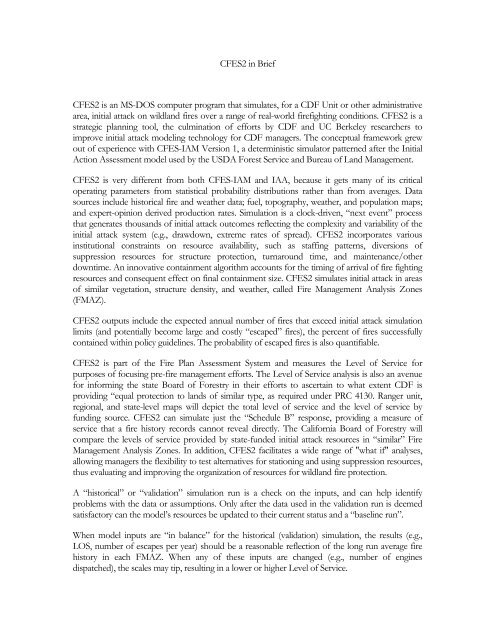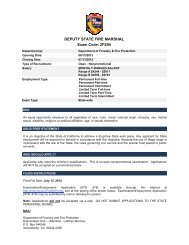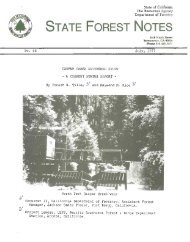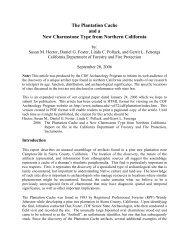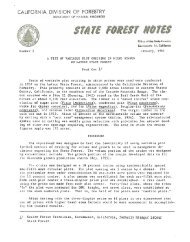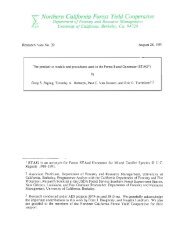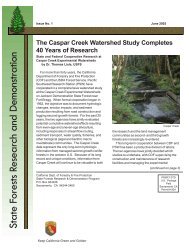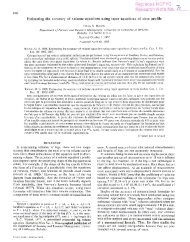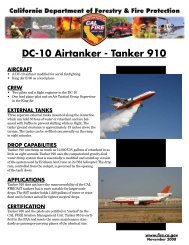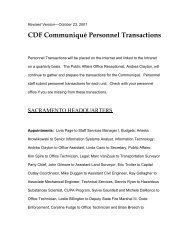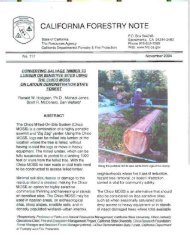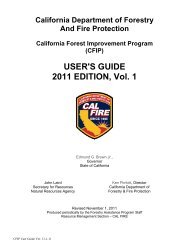You also want an ePaper? Increase the reach of your titles
YUMPU automatically turns print PDFs into web optimized ePapers that Google loves.
CFES2 in Brief<br />
CFES2 is an MS-DOS computer program that simulates, for a CDF <strong>Unit</strong> or other administrative<br />
area, initial attack on wildland fires over a range <strong>of</strong> real-world firefighting conditions. CFES2 is a<br />
strategic planning tool, the culmination <strong>of</strong> efforts by CDF and UC Berkeley researchers to<br />
improve initial attack modeling technology for CDF managers. The conceptual framework grew<br />
out <strong>of</strong> experience with CFES-IAM Version 1, a deterministic simulator patterned after the Initial<br />
Action Assessment model used by the USDA Forest Service and Bureau <strong>of</strong> Land Management.<br />
CFES2 is very different from both CFES-IAM and IAA, because it gets many <strong>of</strong> its critical<br />
operating parameters from statistical probability distributions rather than from averages. Data<br />
sources include historical fire and weather data; fuel, topography, weather, and population maps;<br />
and expert-opinion derived production rates. Simulation is a clock-driven, “next event” process<br />
that generates thousands <strong>of</strong> initial attack outcomes reflecting the complexity and variability <strong>of</strong> the<br />
initial attack system (e.g., drawdown, extreme rates <strong>of</strong> spread). CFES2 incorporates various<br />
institutional constraints on resource availability, such as staffing patterns, diversions <strong>of</strong><br />
suppression resources for structure protection, turnaround time, and maintenance/other<br />
downtime. An innovative containment algorithm accounts for the timing <strong>of</strong> arrival <strong>of</strong> fire fighting<br />
resources and consequent effect on final containment size. CFES2 simulates initial attack in areas<br />
<strong>of</strong> similar vegetation, structure density, and weather, called Fire Management Analysis Zones<br />
(FMAZ).<br />
CFES2 outputs include the expected annual number <strong>of</strong> fires that exceed initial attack simulation<br />
limits (and potentially become large and costly “escaped” fires), the percent <strong>of</strong> fires successfully<br />
contained within policy guidelines. The probability <strong>of</strong> escaped fires is also quantifiable.<br />
CFES2 is part <strong>of</strong> the Fire Plan Assessment System and measures the Level <strong>of</strong> Service for<br />
purposes <strong>of</strong> focusing pre-fire management efforts. The Level <strong>of</strong> Service analysis is also an avenue<br />
for informing the state Board <strong>of</strong> Forestry in their efforts to ascertain to what extent CDF is<br />
providing “equal protection to lands <strong>of</strong> similar type, as required under PRC 4130. Ranger unit,<br />
regional, and state-level maps will depict the total level <strong>of</strong> service and the level <strong>of</strong> service by<br />
funding source. CFES2 can simulate just the “Schedule B” response, providing a measure <strong>of</strong><br />
service that a fire history records cannot reveal directly. The <strong>California</strong> Board <strong>of</strong> Forestry will<br />
compare the levels <strong>of</strong> service provided by state-funded initial attack resources in “similar” Fire<br />
Management Analysis Zones. In addition, CFES2 facilitates a wide range <strong>of</strong> "what if" analyses,<br />
allowing managers the flexibility to test alternatives for stationing and using suppression resources,<br />
thus evaluating and improving the organization <strong>of</strong> resources for wildland fire protection.<br />
A “historical” or “validation” simulation run is a check on the inputs, and can help identify<br />
problems with the data or assumptions. Only after the data used in the validation run is deemed<br />
satisfactory can the model’s resources be updated to their current status and a “baseline run”.<br />
When model inputs are “in balance” for the historical (validation) simulation, the results (e.g.,<br />
LOS, number <strong>of</strong> escapes per year) should be a reasonable reflection <strong>of</strong> the long run average fire<br />
history in each FMAZ. When any <strong>of</strong> these inputs are changed (e.g., number <strong>of</strong> engines<br />
dispatched), the scales may tip, resulting in a lower or higher Level <strong>of</strong> Service.


